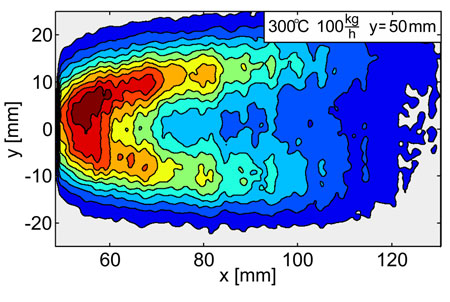| Oct 01, 2015 |
Diesel exhaust gases without any nitric oxides - is that possible?
|
|
(Nanowerk News) The scandal surrounding VW has thrust nitric oxide (NOx) emissions from diesel vehicles into the limelight. Owing to the different engine technologies, these have always been higher than in gasoline-powered cars. On the other hand, diesel consumes less fuel. If a way can be found to “denitrify” diesel emissions efficiently, we would have an economical, clean engine. Empa researchers are thus working hard on optimizing the catalytic converter technology for diesel.
|
|
Diesel engines burn their fuel more efficiently compared to their gasoline counterparts – and thus emit considerably lower quantities of the greenhouse gas carbon dioxide (CO2) – mainly because diesel engines work with excess air in so-called lean-burn mode. Due to the “excess” oxygen in the exhaust gas, however, the three-way catalytic converter we know from gasoline engines, which breaks down more than 98 percent of the toxic NOx in the exhaust gas, cannot be used in diesel engines.
|
 |
| The analyses at Empa’s engine lab reveal the planar distribution of AdBlue in diesel exhaust gas (red = high concentrations; blue = low concentrations). An even distribution of the “cleaning substance” AdBlue would be optimal.
|
|
In order to clean diesel exhausts of NOx, a method is used that was originally developed for the denitrification of power plant exhaust gases. Around ten years ago, the first trucks with this new technology hit the roads. The method uses an aqueous urea solution bearing the tradename “AdBlue” to convert the NOx into harmless nitrogen via various chemical reactions in a special SCR (selective reduction) catalyst that has been optimized for NOx reduction. AdBlue is carried in a separate tank in the car and needs to be topped up every now and again, usually while the vehicle is being serviced.
|
|
However, SCR systems are considerably more complex than a conventional three-way catalytic converter in gasoline engines. For instance, the AdBlue dosage needs to be set precisely to the amount of NOx emitted by the engine. Too low a dosage does not yield the NOx reduction prescribed by law and too high a dosage results in undesirable ammonia emissions. And at temperatures below 200°C, AdBlue tends to form residues that eventually clog up the SCR catalyst. Consequently, SCR systems have to be adjusted specifically to the various engine types and expected load change – i.e. drivability – and optimized, which is a complex and thus expensive process.
|
|
EURO-6: same NOx ceiling for gasoline and diesel
|
|
SCR systems have only just started to be used in diesel cars. The limits currently prescribed in both Europe and the US require SCR catalysts to reduce the NOx level in diesel exhaust gas by more than 95 percent. Moreover, thanks to the EURO-6 norm introduced in September 2014, the same NOx limits now apply for gasoline and diesel vehicles for the first time. Beforehand, the latter had always been allowed slightly higher NOx emissions in Europe.
|
|
Empa’s Laboratory of Automotive Powertrain Technologies headed by Christian Bach has been studying such systems for a number of years and set up a special high-temperature flow lab. Two doctoral students in Bach’s team are currently investigating various AdBlue injection procedures with a view to achieving the most optimal nebulization and homogenous distribution of the aqueous urea solution in the exhaust gas. The researchers use laser-based measuring techniques to quantify and visualize the AdBlue droplets in the flow of exhaust gas, and study their vaporization and chemical conversion.
|
|
Better technical understanding for cleaner diesel
|
|
The experimental results are used in collaboration with colleagues from ETH Zurich and the Politecnico di Milano to parameterize computer simulations of the AdBlue injection physically correctly and validate the simulation models. Such simulations then enable the conversion rate of the catalytic converter to be predicted under different operating conditions. “Empa is therefore contributing towards reducing the NOx in diesel exhaust gas even further,” says Bach. “The better we understand these technologies in detail, the more cleanly diesel vehicles will run on the streets.” The projects are backed by the Federal Office for the Environment (FOEN) and the Competence Center Energy and Mobility (CCEM) in the ETH Domain, and conducted in collaboration with various industrial partners.
|

